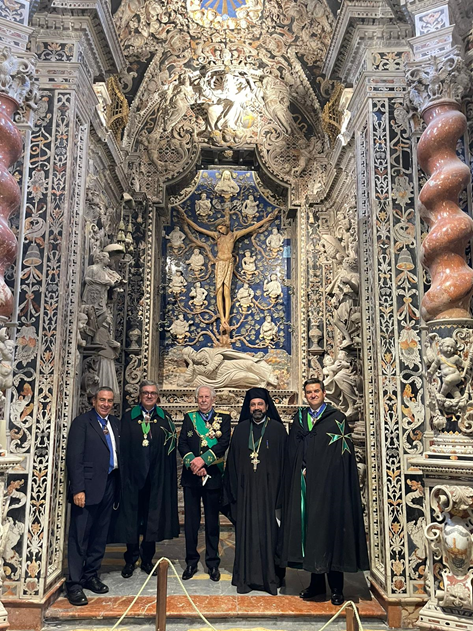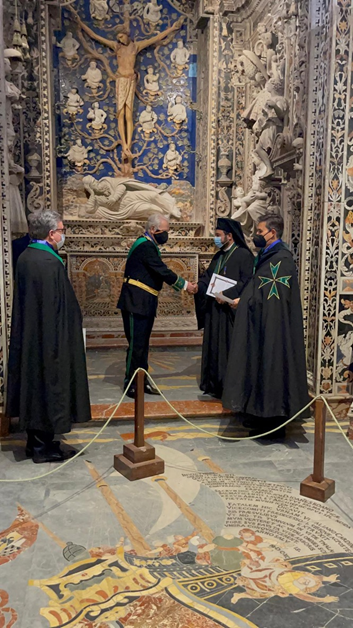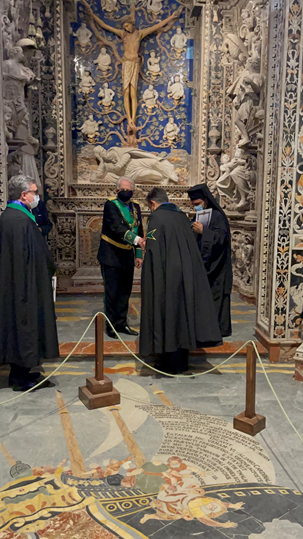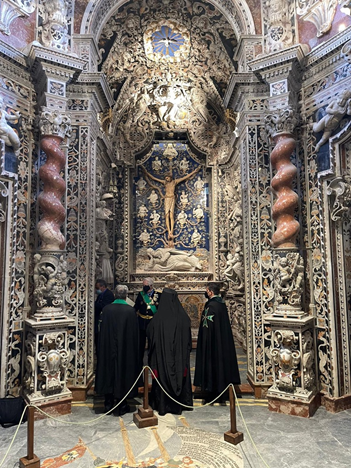TRE MEMBRI DEL GRAN BALIATO AMMESSI NELLA REAL MAESTRANZA DI CAVALLERIA DELL’AVANA
TRE MEMBRI DEL GRAN BALIATO AMMESSI NELLA REAL MAESTRANZA DI CAVALLERIA DELL’AVANA
Il Gran Balì di Sicilia S.E. Dr. Pino Zingale, GCLJ-J, il Segretario Generale del Gran Baliato Prof. Antonino Longo, KCLJ ed il Rev.mo Mons. Chihade Abboud, CHLJ, Aprocrisacrio presso la Santa Sede del Patriarca Greco Melkita di Antiochia, tutti membri del Gran Baliato di Sicilia, sono stati ammessi nella Real Maestranza di Cavalleria dell’Avana nel corso di una breve cerimonia svoltasi presso la Cappella del Crocefisso detta anche “Cappella del Roano”, da Giovanni Roano, arcivescovo spagnolo alla guida della diocesi di Monreale tra il 1673 e il 1703 che ne volle la costruzione, desiderandovi ospitare il crocifisso ligneo quattrocentesco che una tradizione considerava dono del re Guglielmo II d’Altavilla, cui si deve la costruzione nel XII secolo del Duomo.
La cerimonia, durante la quale sono state consegnate le insegne ed i diplomi ai nuovi membri, è stata presieduta da S.E. Don Alfredo Garcia Til, Cavaliere Gran Croce di Giustizia e Commendatore Emerito di Andalusia dell’Ordine di San Lazzaro di Gerusalemme, membro del Venerando Capitolo dei Cavalieri di San Lazzaro di Gerusalemme in Monreale e della Real Maestranza di cavalleria dell’Avana, su delega Excmo. Sr. D. José Gonzalo Ruiz De Bucesta Y Mora, Marqués de Monasterio, Teniente de Hermano Mayor della Real Maestranza.
La Real Maestranza de Caballería de La Habana (MCH), l’unica fondata in una capitale d’oltremare, fu creata nel 1709, sotto l’ispirazione del sivigliano Don Laureano de Torres Ayala (1649-1725), cavaliere dell’Ordine di Santiago e marchese di Casa Torres.
Le Reali Maestranze di Cavalleria sorsero in diverse città andaluse e levantine durante il regno di Don Carlos II, come corporazioni cavalleresche private con un carisma sportivo. La Corona li sosteneva perché servivano a migliorare l’allevamento dei cavalli e ad addestrare i futuri ufficiali di cavalleria per gli eserciti reali. La prima fu a Ronda (creata nel 1572), seguita da Siviglia (1670), Granada (1686), Valencia (1690) sulla terraferma, e L’Avana (1709) oltremare. In una seconda fase, le Reales Maestranzas furono istituite come corporazioni ufficiali poste sotto l’autorità reale, e dotate di giurisdizione e privilegi militari, dedicate alla promozione dell’allevamento di cavalli come riserva della Cavalleria. A partire dal 1725, la Corona e lo Stato concessero alla Maestranza importanti privilegi che diedero loro un riconoscimento giuridico, elevandole a corporazioni nobiliari rappresentative.
Una volta scomparso questo dominio reale nel XIX secolo, la Real Maestranza ammette come membro qualsiasi persona senza bisogno di alcun legame con Cuba, nonostante. Ai membri viene dato il titolo di Ilustrísimo o Ilustrísima.
Ne fa parte il Gran Maestro Emerito dell’Ordine di San Lazzaro di Gerusalemme, Excmo. Sr. D. Francisco de Borbón y Escanasy, Duca di Siviglia e Grande di Spagna, e vi ricopre la carica di Cappellano d’Onore Sua Eminenza Reverendissima l’Arcivescovo dell’Avana.
THREE MEMBERS OF THE GRAND BAILIWICK ADMITTED TO
THE ROYAL MAESTRANZA OF CHIVALRY OF HAVANA
The Grand Bailiff of Sicily H.E. Dr. Pino Zingale, GCLJ-J, the Secretary General of the Grand Bailiwick Prof. Antonino Longo, KCLJ and the Most Reverend Mons. Chihade Abboud, CHLJ, Aprocrisy to the Holy See of the Greek Melkite Patriarch of Antioch, all members of the Grand Bailiwick of Sicily, were admitted to the Royal Maestranza of Chivalry of Havana during a brief ceremony held at the Chapel of the Crucifix also known as the „Chapel of Roano“ (Giovanni Roano), the Spanish archbishop who led the diocese of Monreale between 1673 and 1703, and who commissioned the construction of the chapel, as he wished to house the 15th-century wooden crucifix that tradition considers a gift from King William II of Altavilla, who was responsible for the construction of the cathedral in the 12th century.
The ceremony, during which the insignia and diplomas were presented to the new members, was presided over by H.E. Don Alfredo Garcia Til, Knight Grand Cross of Justice and Commander Emeritus of Andalusia of the Order of St. Lazarus of Jerusalem, member of the Venerable Chapter of the Knights of St. Lazarus of Jerusalem in Monreale and of the Royal Maestranza of Chivalry of Havana, by delegation of Excmo. D. José Gonzalo Ruiz De Bucesta Y Mora, Marqués de Monasterio, Teniente de Hermano Mayor of the Royal Maestranza.
The Royal Maestranza of Havana (MCH), the only one founded in an overseas capital, was created in 1709, under the inspiration of the Sevillian Don Laureano de Torres Ayala (1649-1725), Knight of the Order of Santiago and Marquis of Casa Torres.
The Royal Maestranza sprang up in several Andalusian and Levantine cities during the reign of Don Carlos II, as private chivalric guilds with a sporting charisma. The Crown supported them because they served to improve horse breeding and to train future cavalry officers for the royal armies. The first was in Ronda (created in 1572), followed by Seville (1670), Granada (1686), Valencia (1690) on land, and Havana (1709) overseas. In a second phase, the Royal Maestranzas were established as official guilds placed under royal authority, and endowed with military jurisdiction and privileges, dedicated to the promotion of horse breeding as a reserve for the Chivalry. From 1725 onwards, the Crown and the State granted the Maestranzas important privileges that gave them legal recognition, elevating them to representative noble guilds.
Once the Cuba’s royal dominion disappeared in the 19th century, the Real Maestranza admitted as a member any person without any connection to Cuba, notwithstanding. Members are given the title of Ilustrísimo or Ilustrísima.
Its members include the Grand Master Emeritus of the Order of St. Lazarus of Jerusalem, Excmo. D. Francisco de Borbón y Escanasy, Duke of Seville and Grand Duke of Spain, and His Reverend Eminence the Archbishop of Havana as Chaplain of Honour.
UDALOSTI
- S nádejou k jednote: Zvolenie Leva XIV. ako nového pápeža 9. mája 2025
- Pápež LEV XIV 9. mája 2025
- THE CHURCH OF SAN LAZZARO IN PAVIA 4. mája 2025
- NEW PUBLICATION OF THE INTERNATIONAL ACADEMY OF THE ORDER OF SAINT LAZARUS 29. apríla 2025
- The Order’s Spiritual Protector His Beatitude Youssef I Absi, Patriarch of Antioch and All the Orient, of Alexandria and of Jerusalem and head of the Melkite Greek Catholic Church, took part in the funeral of Pope Francis in St. Peter’s Square, Vatican City today. 27. apríla 2025
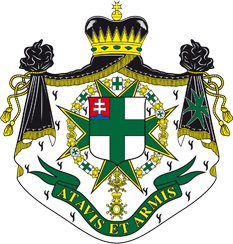
 Military and Hospitaller Order of St.Lazarus of Jerusalem Grand Priory Slovakia,
Military and Hospitaller Order of St.Lazarus of Jerusalem Grand Priory Slovakia,